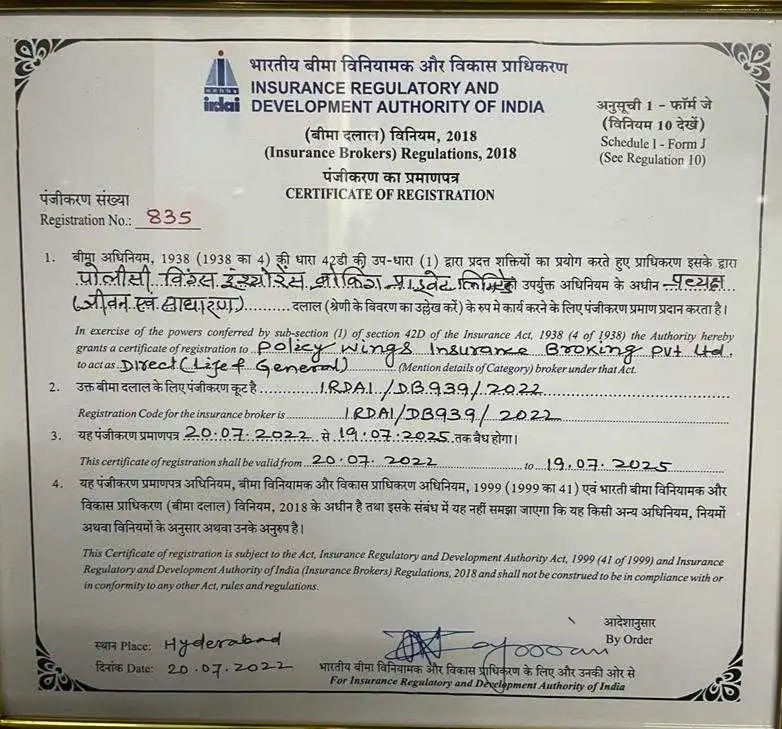Mediclaim Policy
Mediclaim Policy
There has been an increase in the cost of healthcare services as a result of medical inflation. As a result of a medical emergency, your lifetime savings will be gone in no time if you end up being taken to the hospital as a result of a medical emergency.
When it comes to paying for expensive medical care without depleting your resources, having a health insurance policy is one of the easiest and most convenient ways to do so.
Mediclaim Policy: What is it?
A Mediclaim policy is a type of health insurance that pays exclusively for hospital-related medical expenses. As long as the total insured limit has been reached, medical coverage for hospitalization costs can be provided.
The Mediclaim is available on an individual basis and on the basis of a floater amount insured, and it also provides the policyholder with cashless treatment options at hospitals that are part of the insurer’s network.
Benefits of Buying a Mediclaim Policy
Hospitalization and healthcare costs are going through the roof as a result of the rise in lifestyle disorders nowadays.
You can receive financial assistance during hospitalization in the event of a medical emergency by buying a medical insurance policy. Here are just a few of the many advantages of buying a medical policy:
- Cost-effective: Using medical policy coverage will help you get healthcare without depleting all of your funds.
- Cashless Treatment: Your insurance provider’s network hospitals all offer cashless hospitalization services, so there are never any out-of-pocket costs in the event of a medical emergency.
- Financial Stress Reduction: By providing financial support in the event of a medical emergency, it lessens the financial strain on the policyholder and his or her family.
- Family and Individual Floater Cover: Individual and family floater plans are both offered on the market.
- Hospitalization costs: The Mediclaim policy pays for inpatient hospital costs associated with a sickness or unintentional damage, including OT costs, doctor’s fees, nursing costs, medication costs, etc.
- Additional perks: It includes a number of extra perks, including ICU fees and lodging rent.
- Tax Exemption Advantages: The annual policy premium can be used to get tax advantages under Section 80D.
Types of Mediclaim Policies in India
In India, there are several kinds of medical insurance policies. You may select a policy based on your healthcare requirements and receive medical care in confidence.
Let’s examine the various Mediclaim policy categories:

Only the policyholder is covered under a personal medical insurance policy. Under this sort of coverage, only one person may use the Mediclaim policy benefits in exchange for the premium.
In India, a number of health insurance providers provide individual medical coverage.

A family floater mediclaim policy covers the policyholder’s immediate family, such as parents, spouses, and kids. Each family member has access to the same total insured amount under this type of coverage on a floater basis.

The purpose of a senior citizen’s mediclaim policy is to pay for hospitalization costs incurred by seniors over the age of 60.
The senior citizen health insurance policy coverage is tailored to meet their specific medical requirements.

Because critical illnesses have substantial medical costs, this policy covers coverage for conditions like cancer, renal failure, cardiovascular diseases, etc.

With this kind of, you are able to submit claims for hospitalisation costs that you incurred while travelling abroad.

This kind of policy is an option for people who want less protection. Additionally, these measures support the socially disadvantaged. Employers in small and medium-sized businesses typically get this insurance to provide affordable coverage for their workers.
Comparison Between Mediclaim Policy and Health Insurance:
Mediclaim is often used as a synonym for health insurance plans. Both these types of health plans are indemnity comprehensive health insurance plans but there are quite a few differences between the two, such as:
| Parameters | Health Insurance | Mediclaim Policy |
| Meaning | In addition to hospitalisation costs, a health insurance plan covers medical charges. Additionally, it provides a one-time payment for the diagnosis of any serious sickness. | The medical expenses incurred exclusively while in the hospital are covered by the Mediclaim policy. |
| Coverage scope | It pays for things like ambulance fees, hospital bills, critical illnesses, daycare treatments, etc. | It offers coverage for hospitalisation due to a sickness or accident. |
| Add-on covers | It offers a variety of add-on coverages, including critical sickness insurance, maternity benefits, international coverage, etc. | It does not include any additional covers. |
| Premium | Compared to a mediclaim policy, the cost of health insurance is higher since it offers whole coverage. | Due to the policy’s restricted coverage, the premium cost is low. |
How Does Medical Insurance Work?
Mediclaim begins with the selection of the appropriate policy. Considering the variety of health insurance policies available, each with different coverage limits, premiums, and deductibles, be sure to review the policy terms and conditions to ensure they meet your needs.
To activate your policy, you must pay the premiums once you have chosen a policy that meets your needs.
If you require medical treatment following coverage, visit a network hospital and provide your policy details to the third-party administrator (TPA).
The remaining steps will be handled by the TPA. When filing a reimbursement claim, you will need to submit all receipts and bills related to your medical treatment.
Your medical expenses will be reimbursed by your health insurance company if your claim is approved. It is important to keep in mind that your insurance company will only reimburse you for costs covered by your policy.
To ensure that you understand the coverage limits and deductibles, you should carefully review the policy terms and conditions.
What is covered in a Mediclaim Policy?
Good mediclaim policy coverage will protect you from a variety of medical costs; however, the specifics will differ across policies.
The following are some of the most typical components of a Mediclaim policy:
- In-patient Hospitalisation Costs:
This category comprises all medical costs incurred while the policyholder or insurance beneficiaries were in the hospital. It covers costs for things like diagnostic tests, OT fees, medications, blood, x-rays, oxygen, etc. - Pre- and Post-Hospitalisation Expenses:
Medical expenses incurred prior to being admitted to the hospital and after discharge from the hospital are covered. To find out if this kind of hospitalization is covered by your insurance, you must speak with the insurer. - Day-care Costs:
Medical costs associated with cutting-edge procedures that don’t keep the patient in the hospital for more than 24 hours are reimbursed. - Room rent:
Through the cashless facility, costs for standard wards or intensive care units (ICU) are completely covered, subject to the applicable limits, if any. - Doctor’s or Medical Professional’s Fee:
The cost of a doctor’s consultation or that of a medical professional, such as a nurse, is covered.
This list is not exhaustive but only indicative.
What is Not Covered in the Mediclaim Policy?
Every medical insurance policy has specific exclusions, and they differ between insurance providers. The following are some typical mediclaim policy exclusions, unless specifically :
- Pre-existing Medical illnesses:
Until the conclusion of the waiting period, the majority of Mediclaim policies do not cover pre-existing medical illnesses like diabetes, high blood pressure, etc.
While the waiting time is usually 30 days for insurance in order to file a claim, except in personal accident cases, it may be up to a year or longer if there are pre-existing medical issues. - Alternative Therapies:
Alternative therapies like homoeopathy, acupuncture, yoga, etc. are not covered by Mediclaim health insurance coverage. - Cosmetic surgeries:
Any type of medical care, such as plastic surgery, that aims to improve a person’s appearance is not covered by medical insurance. However, hospitalization for aesthetic procedures after an accident or injury can be covered. - Transmission-related Diseases:
Usually, Mediclaim health insurance policies permanently exclude coverage for any transmission-related diseases, such as HIV and AIDS. - Congenital abnormalities:
In India, the majority of medical insurance policies do not cover genetic abnormalities or pre-existing ailments.
How is the Mediclaim Premium Calculated?
Age, location, the amount insured, any existing medical conditions (if any), the scope of coverage, the number of covered members, etc. are all taken into account when insurance firms determine the mediclaim policy price.
However, in accordance with IRDAI norms, the insurer will determine the ultimate rate depending on your individual needs and financial requirements.
Things to Remember When Buying the Best Mediclaim Policy
- Sum Insured:
While choosing the best mediclaim policy, you must ensure that you select a sum insured that is adequate or a coverage amount that is adequate.
It is crucial that you choose a policy that is suited to your requirements regardless of the fact that you might have to pay a greater premium for a larger sum of money promised. - Individual- Family Floater:
Before you finalize your mediclaim policy, you should check to see if this coverage is for your entire family or just you.
As opposed to this, the beneficiaries of a family floater-type medical insurance policy, on the other hand, would own the entire sum of the policy jointly with you. - Co-payment:
This provision stipulates that the policyholder is responsible for paying a certain percentage of medical claims, while the insurer covers the rest of the costs related to medical care. - Network of Hospitals:
It is important to choose an insurance company that has a large network of hospitals because only these hospitals provide a cashless facility.
As a result, you will be able to choose from a variety of options available to you. Insurance companies have a waiting time before which you cannot make a claim for any medical costs. Additionally, there is a waiting time for pre-existing conditions with insurance carriers. - Add-ons:
Most insurance companies do not provide add-ons for their mediclaim policies, but if they do, you can purchase them to expand your insurance coverage. Please be aware that adding on will raise the cost of your insurance.
Eligibility Criteria of a Mediclaim Policy
| Categories | Specifications |
| Minimum age | Children: 90 days Adult: 18 years |
| Maximum age | Children: 25 years Adult: 65 years |
| Family Members Covered | Self, spouse, parents with children who are dependent, and in-laws |
| Renewability | Lifetime |
Documents Required
The list of papers that must be supplied in order to obtain a Mediclaim policy is provided below:
- Completed application form Age Verification: Passport, Aadhar Card, PAN Card, Voter ID Card, etc.
- Identification documents include a driver’s license, passport, PAN card, and Aadhar card.
- Driving licenses, ration cards, utility bills, Aadhar cards, passports, and voter ID cards are examples of address proof.
- Two photos in passport size
- Health test results
Mediclaim Policy Claim Process
A reimbursement claim and a cashless claim are the two sorts of claims that you may make under a mediclaim policy. The claim process is described below.
Cashless claim Process
As the insurer pays the hospital’s bill directly, cashless claims guarantee that a patient will receive cashless care in a network hospital. This means that the insured person owes the hospital nothing for the care they get.
To submit a cashless claim, follow the instructions below:
- Visit a hospital that is affiliated with your insurance provider to obtain treatment.
- Pick up pre-authorization paperwork from the hospital’s insurance counter.
- Complete the form as required, giving accurate information, and have the hospital stamp it.
- The Third Party Administrator (TPA) or the insurer will receive the document from the hospital for approval.
- The company will thoroughly review the paperwork before approving the therapy and fax confirmation of payment to the hospital.
- Obtain treatment, and after release, sign all paperwork.
- The hospital bill sum will be covered by your insurance.
Reimbursement claim Process
As a result, if you need to file a reimbursement claim, it is essential that you notify your insurance provider as soon as a hospitalisation has taken place or is about to take place.
This can be done by contacting the customer service department of your insurance company, or by sending an email to them.
The hospital should be able to provide you with all your medical records once the treatment has been completed.
It is important that you provide your insurance company with a copy of the original discharge card, the claim form, as well as any hospital bills, payment receipts, and pharmaceutical invoices in order for you to be reimbursed.
As soon as your claim has been examined and the reimbursement sum has been paid, the insurance provider will notify you.
Conclusion
A medical emergency can occur at any time, and if you are not covered by a health insurance policy, then you may find yourself with a massive medical bill in the event that you are hospitalized.
We ignore and do not cover our family and ourselves with a mediclaim policy despite the rising costs of healthcare, despite the fact that they are expensive.
As a result, we find ourselves in a precarious position when it comes to medical emergencies. To protect yourself from financial risks, it is important to be proactive and take the necessary steps to protect yourself and your family from them.
The decision to invest in a health insurance policy is one that you should make wisely.
Frequently Asked Questions
There are requirements that must be met for a domiciliary hospitalisation.
This includes medical care if it lasts more than three days, the patient's condition prevents moving to a hospital for treatment, or if there isn't room for them in a hospital.
There are also several exceptions from the domiciliary hospitalisation policy. To learn about the conditions that are not covered, see the policy wording.
In accordance with IRDAI rules, all Mediclaim plans must provide coverage for hospitalisation costs associated with the coronavirus. A few insurance companies also supply clients with particular coronavirus health insurance plans. It is preferable to confirm with your insurer, nevertheless, if COVID-19 treatment costs are covered.
It pays for all hospital costs, including OT fees, medication costs, oxygen costs, blood costs, and other costs incurred during treatment. Additionally, it covers the expense of cutting-edge medical procedures and diagnostic testing.
The age requirement to purchase coverage often varies from insurer to insurer. It typically covers anyone between the ages of 18 and 65 and even includes newborns beginning at 91 days old.
Some schemes provide perpetually renewable resources. Before selecting a plan, you must review the qualifying requirements of medical insurance coverage.
I would like to tell you that one of the first things you need to do is to inform the TPA of your hospitalization as soon as possible, providing them with information about your policy, the hospital, and the necessary treatment.
The claim form must be filled out and delivered to the TPA or the insurer along with any necessary paperwork, along with the claim form.
Whenever you make a reimbursement claim, the claim amount will be paid to you as soon as the insurance company receives all of the required paperwork from you.
There are a couple of things to keep in mind when making a cashless claim: if you receive a pre-authorization before your treatment begins, the insurer pays the hospital directly.
Leading Health Insurance Companies





Latest Blogs
Introduction Future planning is not limited to only savings or investments but creating a safety guard that protects your family even when you’re no longer there to provide. This is why life insurance for family is so essential. It assures that the dreams, milestones and lifestyle of your loved ones remain secure. But the catch is that all life insurance plans are not the same. If you choose the wrong one, you will either end up paying too much or there will be gaps in protection. We will guide you with the best life insurance plans so you can act on it and secure your family’s future. Why Life Insurance is Such a Must-Have Being the primary provider for your family is a huge responsibility. You are practically carrying the entire load and everyone is dependent on you. But what if something unexpected happens to you? Who will take care of your loved ones? Without you, they will struggle so much to maintain even their current lifestyle. Now, if you have a life insurance plan, it will cover the routine expenses, loan EMIs and education & medical costs. You won’t be there but the support to survive will be. The Real Cost of Leaving Your Family Unprotected It’s not even easy to imagine how hard and expensive life can be if the primary earner is suddenly no more. Without proper life insurance for family, all the expenses can quickly pile up and become so overwhelming. Let’s suppose there’s a family with a monthly income of ₹50,000. In case of the death of the main provider, only a coverage of more than ₹1 crore can help them maintain their current lifestyle and meet their future goals. Life insurance plans act as a financial security in your absence. They help families continue living as they have been and in achieving milestones. If you calculate it, not investing in the right plan today is actually going to cost your loved ones a struggle tomorrow. Types of Life Insurance Plans Different life insurance plans are designed to serve different purpose and we must learn more about them to be able to make a smarter decision. Term Life Insurance Plans If you’re looking for life insurance for family, term plans are the most popular and affordable. Basically, it gives high coverage even at a low premium. How it works: You are supposed to pay the premium for a fixed term like 25 years. Now, if during that period something happens to you, your family will receive the full sum assured. Ideal for: If you have a family of dependents, if you have loans or financial responsibilities or if you have just started with financial planning. Benefits: It provides high coverage at low cost, the plan is simple and transparent and there’s an option for add-ons like critical illness cover. Example: A 29-year-old young professional can get ₹1 crore coverage for as low as ₹1000 per month. Whole Life Insurance Plans This plan provides you with lifelong coverage, extending up to 99 or 100 years, which is good enough. It’s just an ideal choice if you want to leave behind a guaranteed financial legacy for your family. How it works: Upon the policyholder’s death, the insurance company pays the sum assured regardless of age. This gives financial support to your family if something unexpected happens to you. Ideal for: Those who want lifelong protection must get it. In fact, it’s perfect for people who want to ensure their assets are passed on to future generations. Benefits: You get lifetime coverage, you leave something substantial for your loved ones and in fact, some plans include cash value or bonus options. Endowment Life Insurance Plans This plan combines the dual benefits of protection and savings. Upon surviving the term, the policyholder receives a maturity benefit. This makes it a dual-purpose plan. How it works: A certain amount of your premium provides life cover and the rest of it goes into a savings part that will earn you returns. Ideal for: Go for it if you prefer disciplined savings or seek guaranteed returns along with protection. Benefits: You get an entire lump-sum amount on maturity of the plan. Plus, being a low-risk savings option makes it attractive. It is certainly ideal for future plans like your child’s education. ULIPs (Unit Linked Insurance Plans) Since these are investment-linked plans, they help you in growing your wealth and also let you enjoy the benefits of life cover. How it works: Some part of your premium goes toward insurance and the remaining amount is invested in equity or debt funds. This totally depends on your preference. Ideal for: People who want both insurance & investment and for those who are long-term investors with moderate to high risk tolerance. Benefits: You get flexibility to switch between funds, there is potential for high returns and you get tax benefits as well under Sec 80C and 10(10D). Imp Note: ULIPs are most suitable for long-term goals. They work best if the investment goes on for at least 10–15 years. Money Back Life Insurance Plans This plan offers regular payouts during the policy term and this makes it a very good choice for those who prefer liquidity. How it works: A share of the sum assured is paid to you at regular intervals. If there’s any remaining amount, it is paid at either maturity or death. Ideal for: Families who need regular cash flow for their expenses or those who want guaranteed returns at specific milestones in their lives. Benefits: It provides a regular income, the life cover continues throughout the policy term and it’s a low-risk investment. Child Life Insurance Plans These plans are specially designed to secure the education and future goals of your child even in your absence. How it works: It’s the parent who is insured and the child is the beneficiary here. In case of the demise of the parent, the insurer forgives all future premiums and continues the
...Buying a car is so exciting. The new smell, the smooth rides. Everything about it seems worth it except for car insurance. Many people see it as a compulsory expense that brings a burden to the wallet every year. However, you just can’t skip it because it’s mandatory in India to have insurance for car. Just by following a few smart and completely legal steps, you can actually cut costs and still enjoy solid coverage. In fact, many car owners are already saving thousands every year! While the internet is full of jargon-filled advice on “how to get the cheapest insurance for car”, we will break it down for you in a very clear and practical way. Why Car Insurance Premiums Feel So Expensive Anyone who has ever renewed their car insurance can relate to the feeling after seeing the premium amount. Every time it seems higher than the previous year, even if you didn’t make a single claim. Here are the reasons why this happens: Rising repair costs: Modern cars have advanced technology. There are smart sensors, digital systems and fancy paint jobs. One small accident and it costs thousands to fix. This makes insurers charge higher premiums. Frequent accidents: India has crowded roads and a lot of traffic, which increases the risk of accidents. When more people make claims, insurance providers spread that burden across all their customers. Add-ons and extras: So many policyholders also buy add-ons without realizing that they will increase the premium. Yes, some features really come in handy but not all of them are necessary for you. Risk-based pricing: Factors like your age, driving history, location and car model also decide the amount. For example, Delhi usually has heavy traffic and thus, higher premiums. All this together can burn a hole in their pocket. But if you be smart about your choices, you can still find the useful and cheapest insurance for car. How to Legally Cut Down Your Car Insurance Costs Premiums feel so heavy on the pocket. But is there any way to reduce them while securing important coverage? Just with perfectly legal ways, you bring down the premium for insurance for car and still stay fully protected. No tricks no loopholes. Compare Before You Commit Even when you book a hotel room, you compare prices. Similarly, you shouldn’t settle for the first quote of insurance for car you get. For the same car, different companies offer different rates and benefits so do a little research. Why it matters: You may dismiss a small difference in premium but counting it all over 5–10 years of owning a car, it can add up to be a big amount. How to do it: Simply use online comparison websites and get multiple quotes. Not just the premium, but also look at what is included and what’s not and customer reviews. Pro tip: The lowest premium is not what you need. Sometimes the cheapest insurance for car may not include roadside assistance or cashless garages that are actually so useful. Seek value for the price. Go for a Higher Voluntary Deductible Many car owners also overlook deductibles. It’s basically the part of a claim you pay before the insurance company comes with its benefits. When you opt for a higher voluntary deductible, you agree to contribute a bit more for a claim. Hence, your insurer gives you a discount on premiums. For example, if you increase your deductible amount from ₹1,500 to ₹4,500, your annual premium could drop by 10–25%. When it works best: If you’re a driver with a good on-road history, this option would suit you. But set your deductible to an affordable amount; otherwise, it becomes a financial strain during accidents. Keep a Clean Driving Record Driving safely is surely the simplest and healthiest way to reduce your car insurance premium. It’s a reward by insurance companies to low-risk drivers because they’re less likely to make claims. Benefits of a clean record: No Claim Bonus (NCB): The year you don’t make a claim, you earn a very good discount. Better premium offers: Your insurer may also give you better rates at renewal. Peace of mind: Obviously, fewer accidents mean overall fewer hassles. Even just by avoiding traffic fines or rash driving, you are seen as a “low risk” driver that brings you closer to the cheapest insurance for car. Choose Add-Ons Wisely Insurance companies will often tempt you with add-ons. Options like zero depreciation cover, engine protection etc are attractive and useful but many of them might just unnecessarily increase your premium. Good add-ons: If yours is a new car, get a zero depreciation cover. If you live in flood-prone areas, get engine protection. Take in the most relevant and practical ones. Not always needed: Add on like roadside assistance may already be offered by your car manufacturer. Similarly, there may be other avoidable ones. Don’t buy all the extras available and rather customize your insurance for car so it fits your lifestyle to reduce your premium significantly. Install Anti-Theft Devices and Safety Features Insurers love cars that have harder to steal features installed. If your vehicle has airbags, alarms, tracking devices or other safety features, it’s going to get you discounts. Why it works: When there’s more security and a lower risk of theft and accident, it also means less financial risk for insurers. How to benefit: If you install an ARAI-approved anti-theft device in your car, some insurers may immediately lower your premium as soon as you give them proof of installation. This is how you can ensure cheaper premiums but also more peace of mind for a safer car. Bonus Tips for Bigger Savings We discussed the five main ways to reduce your premium amount. Here we have a bunch of few more tricks that will help you save money on your car insurance: Renew on time: Late renewals may also lead to losing your No Claim Bonus (NCB). Avoid small claims: Try to pay out-of-pocket for
...Introduction Small and medium enterprises (SMEs) are the support systems of India’s economy which contributes nearly 30% to the GDP and employs millions across diverse sectors and still one of their biggest challenges lies in managing cash flow disruptions caused by delayed payments or outright defaults from buyers. In a cut throat market where access to credit is limited, even one unpaid invoice can hamper an SME’s financial stability. This is exactly when credit insurance in India comes into light as a strong safeguard providing trade credit protection to reduce risks and strengthen business security. Understanding Credit Insurance Credit insurance can also be termed as trade credit insurance or accounts receivable insurance which is a risk management instrument that secures businesses from losses arising due to failure of payment by buyers. If a customer fails due to insolvency, bankruptcy or prolonged delays then the insurer compensates the policyholder for a large portion of the outstanding dues. In the Indian framework, credit insurance provides a protection where delayed payments are a constant concern particularly for SMEs engaging with large corporations or overseas buyers. It makes sure that if a buyer fails to pay even then the business does not face sudden financial stress. Requirement for Trade Credit Protection for SMEs Cash Flow Stability: SMEs usually operate on low budgets and limited reserves. Even one default can interrupt working capital cycles which can make it hard to meet payroll or pay suppliers. Trade credit insurance helps maintain liquidity. Risk Variation: SMEs can benefit from the insurer’s risk assessment expertise which decreases exposure to high risk buyers instead of depending only on internal credit checks. Business Expansion: SMEs can assuredly extend credit to new customers and enter foreign markets including exports with the assurance of credit protection. Improved Borrowing Capability: Banks and financial institutions are more inclined to lend when receivables are insured which can increase the chances of SME’s access to credit. Growth of Credit Insurance in India Over some years, acknowledgement of credit insurance has grown due to rising trade volumes and payment uncertainties. The pandemic further made us focus on the significance of securing receivables as many businesses faced unexpected disruptions in buyer payments. Regulatory support from the Insurance Regulatory and Development Authority of India (IRDAI) has also played a significant part. Guidelines have been amended to make trade credit insurance more reachable to SMEs making sure that they can have coverage without complex procedures. Working of Credit Insurance The SME goes to an insurer or broker to purchase a credit insurance policy. The insurer checks the creditworthiness of the SME’s buyers. A coverage limit is given to each buyer which defines the maximum insured amount. If these’s a default then the SME submits a claim with supporting documents. After verification the insurer compensates a huge percentage of the loss which usually ranges between 75% and 90%. General Benefits for SMEs The most important benefits of credit insurance is recovering unpaid invoices but some extra advancements include: Stronger Negotiation Ability: Insured receivables provide SMEs with significant leverage when negotiating with banks or investors. Global Market Access: trade credit insurance for exporters serves as a safety net against foreign buyer risks, political instability and currency related payment problems. Operational Confidence: entrepreneurs can focus on productive strategies with less financial anxiety rather than tracking overdue payments. Improved Corporate Governance: Insurers often provide insights and data on buyer performance, helping SMEs build disciplined credit policies. Challenges in Adoption Credit insurance in India is still not effectively used despite its benefits. Several elements contribute to this void like: Low Awareness: Many SMEs are not familiar with trade credit protection or assume it is relevant only for big corporations. Perceived Costs: Business owners usually see premiums as an extra cost without acknowledging the potential savings from avoided losses. Complicated Terms: Insurance terms and procedural requirements may put off smaller businesses from exploring policies. Future Expectation for Trade Credit Protection in India The requirement for credit insurance in India is expected to increase gradually due to these reasons: Growing Trade Networks: SMEs will require protection against foreign buyer risks with India’s rising exports. Digital Development: Online platforms are making insurance products more reachable and customisable. Government Initiatives for SME Growth: Policy initiatives such as ‘Atmanirbhar Bharat’ and inducements for exporters will navigate demand for financial protections. Increased Banking Integration: Banks may promote insured receivables as part of lending conditions further which can normalise trade credit protection. Conclusion The risk of buyer defaults is a financial inconvenience and a survival challenge for SMEs in India. Credit insurance in India gives a strong solution by making sure there is trade credit protection, balanced cash flows and encouraging business confidence. Credit insurance will become a necessary part of SME risk management in coming years while challenges in awareness will still remain complex.
...Introduction The increase in digital platforms has evolved the way Indians buy financial products, particularly insurance. Only with a few clicks, anyone can compare policies, calculate premiums and complete the purchase online. Though this easiness comes with a set of complexities. Many first time buyers make notable mistakes during the online policy purchasing. These mistakes turn into financial loss and can also cause legal complications while making claims. Rapid increase in Trend of Online Insurance In the past few years, India has observed an increase in online insurance purchases. Factors like use of day to day smartphone usage, digital literacy and the pandemic driven requirement for no contact services have reinforced individuals to shift to online platforms. While these portals give transparency and convenience, the lack of a physical advisor means buyers have to be extra cautious. Insurance contracts are legally binding agreements and even a small mistake while purchasing can affect the validity of claims in the future. Ignoring Policy Terms and Exclusions The biggest common insurance mistake in India is not reading policy documents precisely. Online buyers mostly lightly go through the terms and conditions and depend on the highlights given on aggregator websites. But exclusions, waiting periods and particular conditions are there as well. The doctrine of utmost good faith can be applied here, which means both insurer and insured have to fully disclose all the material facts. If buyers could not understand exclusions then disputes may rise when claims are denied and courts generally take the side of written contract and not the verbal assurances. Tip: Make sure to download the full policy wording and not just the product brochure. Take time to review/ recheck exclusions, sublimits and definitions. Consulting a financial advisor or legal expert for interpretation can help as well to prevent these types of disputes. Misrepresentation or Incomplete Information Another general error is giving inaccurate or incomplete information while filling proposal forms. Buyers may lie about their smoking habits, not tell about preexisting medical conditions or misreport income levels to get lower premiums. And this can seem harmless but can have serious legal implications. Under Section 45 of the Insurance Act 1938, insurers have the right to deny claims within the first three years if material misrepresentation is catched. Courts have constantly upheld the insurer’s right to deny claims where incomplete material facts affect the risk. So, even if premiums are paid on time, claim settlement can be denied due to false or incomplete declarations. Tip: Make sure that all personal, health and lifestyle information is true and complete. If you are in doubt then be on the safer side and over disclose details rather than concealing them. This makes your legal standing strong, in case of denial in claim. Choosing Cost Over Coverage Many individuals focus mainly on the premium amount and not on the sufficiency of the coverage. Selecting the lowest cost policy can result in incomplete security. Choosing inadequate coverage does not make the insurer liable for extra financial required beyond the agreed sum assured. Courts and consumer forums impose the principle of contracts being binding only to the agreed point. Tip: Rather than choosing the cheapest premium, compare and calculate the policies based on the comprehensiveness of coverage, claim settlement ratio and reputation of the insurer. Also consider affectation and rising medical costs while deciding coverage amounts. Not paying attention to Claim Settlement Ratio Claim settlement ratio (CSR) indicates the percentage of claims an insurer clears up in a financial year. Loads of online buyers ignore checking this essential parameter as they assume every insurer functions uniformly. But, CSR shows the dependency of an insurer in fulfilling claims. A low CSR could mean a greater probability of claim denials which can lead to extended litigation. In many Indian consumer court cases insurers with not good claim histories have been told to compensate policyholders but this type of litigation is time consuming and stressful as well. Tip: Make sure CSR data from the Insurance Regulatory and Development Authority of India (IRDAI) annual reports. Go for insurers with invariably high ratios, preferably above 90%. This decreases the chances of disputes and makes sure quicker claim processing. Ignoring Riders and Add Ons Online platforms mostly show the basic policy without focusing on optional riders like critical illness cover, accidental death advantages or waiver of premium clauses. Buyers who leap from these add ons will surely later regret their decision when facing unforeseen financial requirements. Legally, once a policy is purchased without a rider then the insurer is not bound to extend those advantages even if the buyer presumes differently. Courts follow the principle of contract sanctity and do not take into consideration claims which are beyond the agreed terms. Tip: Calculate if riders can enhance your financial protection. For example a term policy with an accidental death rider should ensure higher payouts in case of accidental death. Pay attention to add ons that match your particular needs before finalising the policy. Not Maintaining Proper Documentation Many buyers fail to keep digital copies of policy documents or payment receipts and while claiming any disputes the documentary evidence is important. Without any strong proof the policyholders can face complications in consumer forums and courts. Tip: Always download and safely maintain your policy documents. Maintain both soft copies and physical copies and make sure that family members know where to retrieve them. This safeguards legal rights in case of disputes. Conclusion Purchasing insurance online offers easiness, convenience, transparency and efficiency. And the shortage of professional guidance means buyers have to be attentive against general mistakes. Misrepresentation, inadequate coverage, ignoring exclusions and poor documentation are mistakes that convey both financial and legal consequences. If you do not want to make these mistakes then individuals should precisely research policies, disclose accurate information, review legal terms and maintain proper documentation.
...Introduction With India urbanizing so quickly, the insurance landscape particularly in the commercial sector has undergone a major change. With cities expanding, real estate development is rising and businesses increasingly exposed to natural and man made disasters are driving record demand for commercial property insurance which is reaching unmatched levels. This part of insurance has shifted far behind just asset protection and has become an important part of risk management for enterprises navigating today’s urban challenges. Rising Demand for Business Property Coverage As India’s business centers grow, the chance of damage from fire, floods, earthquakes, theft and cyber attacks increases. The rise in climate related events has made city properties more at risk. Because of this the business property insurance is now needed for all businesses from small stores to big factories. A big change is that there are more businesses that are buying policies that cover not only buildings but also equipment, stock and business interruption. This complete approach shows that companies understand that the business disruptions can cause bigger financial losses than the cost of fixing physical damage. Regulatory Oversight and Policyholder Protection The Insurance Regulatory and Development Authority of India (IRDAI) guides India’s insurance rules. These rules emphasize clear information, fair pricing and quick claim settlements. Policies have to follow strict rules about what they cover to avoid arguments. For cities facing high risks there is an additional cover option such as earthquake or terrorism protection which are commonly advised. Recent court cases show the legal issues that can come up in business insurance disputes. In some cases before consumer commissions and High Courts the insurers had to pay claims because they rejected them using unclear exclusions or not fully explaining the policy. Courts have said many times that insurance contracts must be handled with honesty and that insurers should interpret policies in a way that benefits the policyholders. This legal trend makes it easier for businesses to get compensation and makes insurers more responsible for handling claims quickly and honestly. Urban Risks Driving Policy Growth India’s urban centers face a wide spectrum of risks and insurance adoption is rising accordingly: Natural Disasters like Flooding in metro regions and seismic risks in northern and northeastern states demand specialised coverage. Densely packed industrial and commercial areas have more fire risks so fire riders are important. Because property crimes are up in cities there is a greater need for protection of inventory and buildings. Since businesses rely on being open all the time then even brief shutdowns can lead to big losses which makes business interruption coverage very important. Urban businesses are realizing property insurance is a necessity rather than just an option because of the risks involved. Digital Change in Commercial Property Insurance Commercial property insurance in India has changed because of digital platforms and AI based risk assessment. Tools can now check how strong buildings are and also location based risks even the weather patterns so insurers can set policy prices better. For those with policies the digital claim systems cut down on paperwork and speed up payments. Also devices like fire sensors and security systems are being added to insurance plans. Companies that use these tools to lower risks often get lower premiums which encourages them to take safety steps. Legal Consequences and Responsibilities Business insurance regulations have a few important responsibilities for insurers and policyholders: Insurers: If an insurer mistakenly denies a claim they may face penalties under consumer protection laws. Courts may also order compensation for emotional distress and legal fees on top of requiring the claim to be paid. Policyholders: If a policyholder does not disclose all important information like previous damage or poor safety procedures, their claims may be rejected and they could face legal action. It is critical to be honest and meet all policy demands. Duty of Good Faith: Courts have confirmed that both sides of an insurance deal have to act honestly and if they don’t then they can be sued and lose money. Strategic Considerations for Businesses Businesses in cities should do risk assessments that look at both building risks and location related risks when picking insurance. Think about using extra coverage options: Things like coverage for natural disasters, theft and business problems can add important protection in cities. Follow the law and be honest when you apply and follow safety rules you can avoid problems with claims and get better insurance options. Use of technology: Prevent problems like fire systems as they have security cameras and they keep monitoring tech which can lower risks and also even lower your insurance costs. Keep up with legal news: Knowing about court decisions can help you be ready for possible legal arguments. Conclusion Commercial property insurance in India has evolved because of the digital platforms and AI based risk assessment. By 2025 the business property insurance will be an important part of how companies in India deal with the risks of fast-growing cities. The higher need for this kind of insurance shows that risks are increasing and that people know more about how insurance can protect them financially. Because rule makers want things to be clear, courts are protecting the rights of people with insurance and technology is making coverage smarter. Property insurance is becoming a main part of keeping businesses going. For businesses it’s vital to pick complete policies, follow the rules and take steps to prevent problems in cities.
...The process of insurance claims being settled in India plays an important role in forming the overall financial and functional plannings of businesses. Companies that propose group health insurance or cover their employees under corporate insurance programs mostly have to face the difficult question of choosing between cashless and reimbursement claims. Both procedures of cashless claims and reimbursement insurance have different advantages and shortcomings, that can make an influence on how employees take their health benefits and how proficiently businesses regulate healthcare expenses. Learning the distinction between both the systems is important for employers, HR professionals and decision makers which manage employee welfare policies. As both eventually help the purpose of covering medical expenses, their processes, timelines and business suggestions vary notably. Learning about Cashless Claims A cashless claim permits an insured individual to obtain treatment at a hospital without making beforehand payments. This benefit is allowed only in hospitals that are part of the insurance company’s grid. When an employee is admitted, the insurer and the hospital reconcile directly and the bills can be cleared without needing the patient or their family to arrange deposits. Additionally the insured person only has to pay for non covered expenses like personal consumables or any exclusions under the policy. For businesses cashless claim insurance portrays an easy way of making sure that employees are not weighed financially through medical emergencies. The arrangement also constructs goodwill among employees as they get the company’s insurance offering as more precious and encouraging. Learning about Reimbursement Insurance In comparison, reimbursement insurance functions on a different structure. The insured person initially pays for the medical expenses from their own pocket, no matter whether the hospital is in the insurer’s grid or not. When the treatment is done, the insured person files a claim with the insurer through providing hospital bills, prescriptions, discharge summaries and other supporting documents. Then the insurer processes the claim and reimburses the amount which was subdued to policy terms and conditions. This structure provides employees freedom to choose hospitals but it comes with the immediate financial load of arranging huge amounts, especially for critical care or high cost surgeries. From a business perspective this structure is less easy in contrast to cashless claims but it gives ease in choosing the hospital. Advantages of Cashless Claims for Businesses The major advantage of cashless claims insurance is the riddance of financial stress during emergencies. Employees not required to arrange huge sums for hospitals can feel secure about their health coverage. This type of protection participates positively to employee happiness and support. Cashless claims also are efficient processes for businesses. HR departments or insurance coordinators in a company find it simpler to assist employees with direct settlements rather than guiding them through complicated reimbursement and paperwork. Additionally in the case of big businesses, handling bulk claims by cashless facilities decreases administrative complications. One more important advantage is transparency. As the insurer and hospital directly interconnect there is slighter chances for fraudulent claims or blown up billing practices by employees. Businesses indirectly benefit from this control as it makes sure that group health insurance premiums remain steady over time. Disadvantages of Cashless Claims for Businesses Despite the advantages the cashless claims come with certain shortcomings. The underlined limitation is network dependency. If an employee seeks treatment at a hospital outside the insurer’s grid then the cashless facility will not be obtainable and the employee will have to fall back on to reimbursement. This sometimes makes dissatisfaction if employees take the grid coverage as deficient. Additionally, insurers may decline cashless approvals for some procedures or expenses they contemplate outside the scope of the policy. This mostly leads to disputes between employees and HR departments keeping businesses in a mediating role. Furthermore, the concern is the possibility for delays in claim approvals. The cashless system is designed to be easy but in practice, hospitals and insurers may take a lot of time even a few days to verify approvals especially in planned procedures. Businesses need to supervise employee expectations relating to these delays. Advantages of Reimbursement Insurance for Businesses Reimbursement insurance is less popular among employees as it has more advantages for businesses. The main advantage is flexibility in hospital choice. Employees can have treatment in any hospital of their choice whether or not it is part of the insurer’s grid. This characteristic is especially valuable in tier-II and tier-III cities where the insurer grid may be limited. From a claims management perspective the reimbursement insurance gives businesses more time to examine and verify claims. As employees submit documentation after treatment then the HR and insurance teams can better evaluate the validity of expenses. This can be a help to reduce disagreements with insurers later. Furthermore, the reimbursement claims certainly work as a backup system for businesses. In cases where cashless claims are denied or not achievable, reimbursement makes sure that employees are still secured financially in addition with a delay. Disadvantages of Reimbursement Insurance for Businesses The main disadvantage of reimbursement insurance is the financial load on employees. In emergency situations expecting employees to arrange big funds upfront can cause distress, affecting morale and productivity. This mostly interprets into dissatisfaction with the employer even though the insurer eventually reimburses the expenses. From a business point of view reimbursement claims need more management participation. HR teams have to accommodate employees in assembling documents, tracing claims and solving disagreements with insurers. This raises workload and can result in damage if claims are held up or partially settled. One more shortcoming is the time gap between the treatment and reimbursement even if the insurer approves the claim the process can take a lot of time like even weeks. For employees this delay can create cash flow complexities, which indirectly affects workplace satisfaction. For businesses this can mean extra grievances and reputational concerns. Right Balance: Conclusion For Indian businesses the flawless route mostly lies in an amalgamation of both systems. Employers can inspire employees to use cashless facilities wherever possible to
...Unexpected challenges have become a common feature of today’s global business outlook. For many travelling professionals having the correct business travel cover means the difference between flawless operations and costly disorganisation. In India the travel insurance for corporate travelers has evolved from being merely optional to becoming a planning necessity, supported by practical benefits and growing legal recognition. Why It’s More Than Just a Protection Business journeys can expose employees and the organisations to diverse risks, which include: Medical emergencies abroad which are paramount to excessive costs without proper coverage. Trip cancellations or holdup/delays can be affected by weather, civil unrest or logistical failures. Loss of baggage or essential business gadgets or equipment like laptops or documents. Legal liabilities arising abroad from third party injury or property damage. Emergency evacuation and repatriation, which can include scenarios of critical health crises or death. Comprehensive business travel policies in India address these by extensive protection offerings such as emergency medical aid, repatriation, document loss, baggage delays and personal liability/travel insurance or business travel cover. Legal Regulations and Precedents Many recent legal results highlight the practical importance of correct travel insurance: In Ghaziabad’s District Consumer Disputes Redressal Commission a couple was given an award of INR 1.9 lakh after their insurance provider falsely classified a cancelled international flight as a delay. The court found inconsistencies in service under the Consumer Protection Act and upheld the rightful full claim amount. The devastating plane crash in Ahmedabad left a broad range of travel and personal insurance claims from baggage loss to life cover underlining how the business insurance provides important financial support in disastrous events. These rulings reinforce that strong business travel cover offers financial security and also legal validation for claims properly documented. Advantage for Corporate Travel Insurance Financial Protection: Medical expenses abroad can shoot up fast. A correct business travel policy makes sure that financial security by hospitalisation, treatment or emergency evacuation coverage eliminates fear of out of pocket burdens. Operational Continuity: Delays and cancellations are the inconveniences. And they disrupt tightly planned meetings or negotiations. Business travel insurance policies often cover nonrefundable costs and ancillary expenses, helping retain business continuity. Protecting Critical Assets: Corporate travelers mostly have to carry certain important equipment and documents and Insurance covers loss, damage, theft or delay of baggage, passports and devices which can totally minimise the operational difficulties and complicated situations. Emergency Assistance or Response and Legal Cover: Policies usually set 24/7 assistance which are mainly for medical coordination, local support, repatriation or legal liaison. They might also cover third party liability claims sustained while travelling. Compliance and Decreasing Risk Some countries require travel insurance as a precondition for visa issuance coverage levels and duration mostly specified. Failing to comply can endanger visa approval or entry. Without proper business travel cover the employees and their organisations risk financial exposure can have potential claim rejections or insufficient recourse in emergencies. Consequences of not having it Refused claims like misidentification of cancellations which can result in limited or partial reimbursement. The Ghaziabad case serves as a preventive precedent. Insufficient coverage can lead to uncovered expenses such as replacement of equipment, legal disputes or emergency evacuations which are not in the policy. In critical situations there can be a lack of instant assistance that can intensify risks, delay responses or shoot up liabilities. How to Select the Right Business Travel Cover Make sure that it has a wide scope which includes medical, cancellation, baggage, evacuation, liability and repatriation cover. Customise to select single trip or multi trip covers depending on travel occurrence and make sure that coverage limits match the destination risk profiles. Understand the exclusions and the common exclusions include pandemics, war or preexisting conditions. Review/recheck policy gradation thoroughly. Choose providers offering constant active assistance 24/7 support, claim facilitation and local coordination improve real time security. Conclusion Integrating travel insurance into the corporate travel policy outlines is no longer just advisable it’s crucial. By protecting financial liabilities by enabling swift emergency response and providing legal recourse then a business travel cover makes sure that the corporate travelers can centre the focus on their target with reliance and confidence. From present consumer court precedents to developing global risks the case is clear that comprehensive business travel insurance is a planning and strategic asset and not a load on budgets. For corporate entities dedicated to employee welfare, operational continuity and sensible risk management this is a nonnegotiable investment.
...Group health insurance policies for employees is a main part of employer benefit plans in India. Companies with more than ten employees are required to offer a group medical insurance plan as per the rules established by Insurance Regulatory and Development Authority of India (IRDAI) and Employee’s State Insurance (ESI). This developing change is considered not only compliance but also changing legal requirements and employee expectations. Why Group Health Insurance Is a Legal Essential The social security framework in India is regulated by multiple interconnected laws: The Employee State Insurance Act of 1948 requires coverage for employees in the organised sector with an earning up to INR 21,000 per month. A. The employer contributes 3.25% and the employee contributes 0.75% of the wages. B. Addresses medical care, illness, injury, maternity, disability, family pensions and funeral costs. Insurance Act of 1938 and regulations set forth by the IRDAI A. The IRDAI regulates the terms, pricing and transparency of group insurance as stipulated in Section 34 of the Insurance Act. B. On 1 April 2020, the IRDAI mandated insurers to implement affordable group health plans for organisations returning to operations after the pandemic. Code on Social Security, 2020 Consolidates Employee State Insurance (ESI), Employee’s Provident Fund (EPF), gratuity, maternity benefits and other related benefits into a single framework. Mandatory Coverage: Who & What? Employers with ten or more employees not covered by ESI are required to provide group medical insurance in accordance with the IRDAI circular. Employers subject to ESI are not required to provide supplementary group plans as long as ESI coverage remains in effect. Employees with a monthly income exceeding INR 21,000 who are not covered by ESI but are legally required to obtain group health insurance (GHI) as an alternative. Important Legal Obligations for Employers Obligations of care within common law and statutory frameworks Employers are obligated to ensure workplace health and safety and a responsibility that is both implied in contracts and reinforced by legislation such as the OSH Code 2020. Adherence to the terms set forth by the IRDAI policy The IRDAI mandates disclosures regarding premiums and establishes timelines for claim settlements and even outlines channels for grievance redressal. Insurers are required to provide transparent contracts. Consequences for failure to comply Failure to offer required coverage may attract fines, imprisonment, loss of business licence and reputational harm. Important Differences Between Individual and Group Health Insurance Structure and cost sharing Group policies: employers pay all or part of the premiums; bulk bargaining can lower expenses. Individual: employee paid with modifiable coverage. Scope of coverage Group: includes COVID-19 care, maternity, OPD, ambulance, hospitalisation and pre-existing conditions (often immediate). Individual: may initially rule out pre-existing conditions; requires customised add-ons. Portability Group health plans are subject to IRDAI portability rules which provide continuity in the event of an insurer change. Legal Precedents & Contractual Implications The UK Court of Appeal looked at implied employer duties in insurance benefit plans in Crossley v. Faithful & Gould (2004). Group insurance provisions must be explicitly incorporated into employment contracts in India, with any ambiguities being settled in the worker’s favour in accordance with the rules of contract law. Best Practices for Implementing Group Health Insurance Clarity of eligibility In employment agreements and policy wording which specify covered employees (permanent, contract and trainees). Sufficient levels of sum insured In order to improve retention which is to take into account medical inflation and if possible include parent or family coverage. When appropriate smooth integration with ESI Make sure covered employees are properly identified while avoiding redundant coverage. Audits and policy renewals Engage the finance and human resources and legal departments in yearly reviews of the claims ratio, exclusions and renewals. Communication among employees and the resolution of grievances As required by IRDAI notification has to be sent to staff members of benefits and claim procedures and keep track of grievances. Benefits and Strategic Importance Attracting talent and increasing productivity According to studies insured workers are more dedicated and can take fewer sick days and work longer. Tax advantages Employees benefit from Section 80D deductions for individual health plans and premiums are deductible business expenses. Social and moral accountability Encouraging employee health is in line with Environmental, Social and Governance (ESG) objectives and shows corporate citizenship. Conclusion Employee group insurance is backed by corporate health insurance plans and has transitioned from optional perk to legal imperative in India. The dual framework of ESI Act and IRDAI regulations compels organisations especially those with ten or more employees to implement robust health coverage mechanisms. Employers should view these not as merely statutory burdens but strategic tools to foster wellbeing, loyalty and resilience. Legal perspective: Make policies in accordance with the Code on Social Security 2020 the Insurance Act of 1938 and IRDAI guidelines. Include provisions pertaining to health insurance in employment contracts. To prevent statutory penalties and to keep an eye on compliance. Make use of health benefits to boost output and brand recognition.
...








